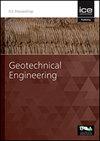Bearing Capacity Prediction of Strip and Ring footings Embedded in Layered Sand
IF 1.7
4区 工程技术
Q3 ENGINEERING, GEOLOGICAL
Proceedings of the Institution of Civil Engineers-Geotechnical Engineering
Pub Date : 2022-10-31
DOI:10.1680/jgeen.22.00071
引用次数: 1
Abstract
In the present study, a prediction model for the bearing capacity estimation of strip and ring footing embedded in layered sand is proposed using soft computing approaches, i.e., Artificial Neural Network (ANN) and Random Forest Regression (RFR). In this regard, the required data for the model preparation was generated by performing a lower and upper bound finite elements limit analysis by varying the properties of the top and bottom layers. Two types of layered sand conditions are considered in the study; namely, (i) dense on loose sand and (ii) loose sand on dense sand. The investigation for strip footing was carried out by varying the thickness of the top layer, embedment depth of the foundation, and friction angles of the top and bottom layers. In the case of ring footing, the internal to external diameter ratio forms an additional variable. The bearing capacity was taken as an average of lower and upper bound values. A total of 1222 and 4204 data sets were generated for strip and ring footings, respectively. The models were trained and tested using 70 % and 30 % of the selected data, and the bearing capacity was predicted in normalized form. The performance measures obtained during the training and testing phase suggest that the Random Forest Regression model outperforms the ANN model. Additionally, following the literature, an analytical model was developed to predict the bearing capacity of strip footing on layered sand. The ANN and the generated analytical model predictions agreed with the published experimental data in the literature.层状砂中带状和环形基础承载力预测
本文采用人工神经网络(ANN)和随机森林回归(RFR)等软计算方法,建立了层状砂土中带状和环状基础承载力的预测模型。因此,模型制备所需的数据是通过改变顶层和底层的性质进行下、上边界有限元极限分析生成的。研究中考虑了两种层状砂条件;即(i)松散砂上的致密砂和(ii)致密砂上的松散砂。对条形基础进行了顶层厚度、基础埋设深度、顶层与底层摩擦角的变化研究。在环形基础的情况下,内径与外径的比值形成了一个额外的变量。承载力取下、上限值的平均值。条带式和环形基座分别产生1222和4204个数据集。分别使用70%和30%的选定数据对模型进行训练和测试,并以归一化形式预测承载力。在训练和测试阶段获得的性能指标表明,随机森林回归模型优于人工神经网络模型。此外,根据文献,建立了一个分析模型来预测层状砂上条形基础的承载力。人工神经网络和生成的分析模型预测与文献中发表的实验数据一致。
本文章由计算机程序翻译,如有差异,请以英文原文为准。
求助全文
约1分钟内获得全文
求助全文
来源期刊
CiteScore
4.40
自引率
4.50%
发文量
68
审稿时长
3 months
期刊介绍:
Geotechnical Engineering provides a forum for the publication of high quality, topical and relevant technical papers covering all aspects of geotechnical research, design, construction and performance. The journal aims to be of interest to those civil, structural or geotechnical engineering practitioners wishing to develop a greater understanding of the influence of geotechnics on the built environment.

 求助内容:
求助内容: 应助结果提醒方式:
应助结果提醒方式:


